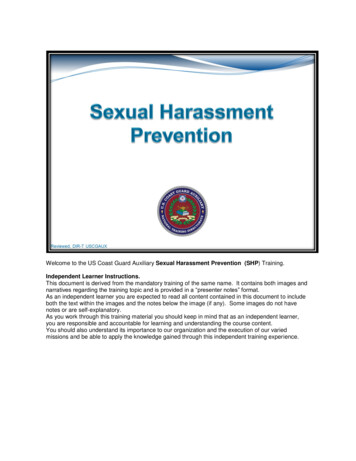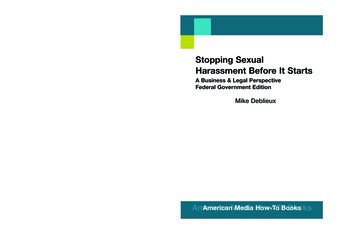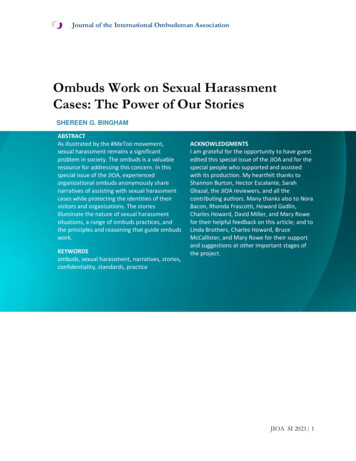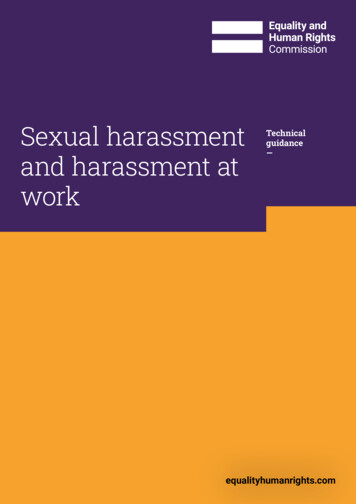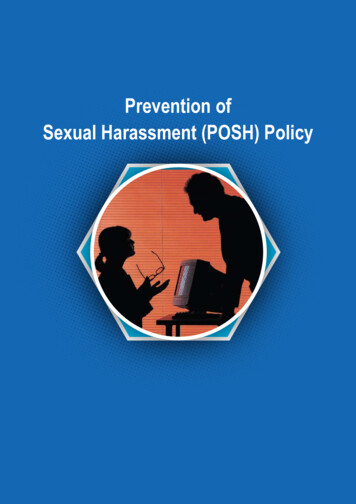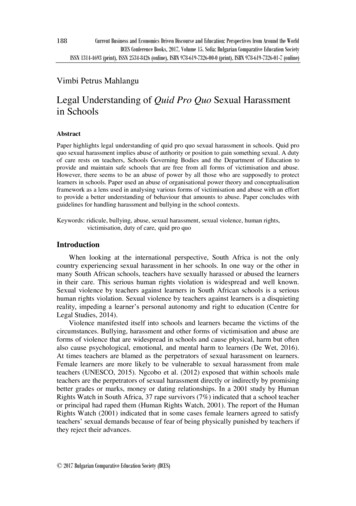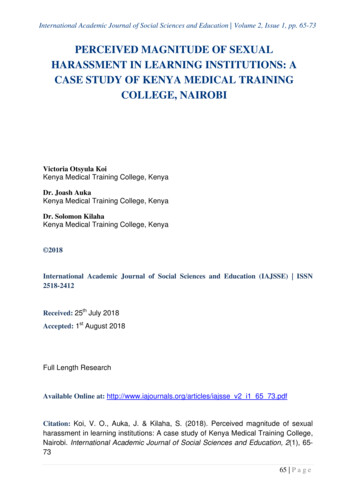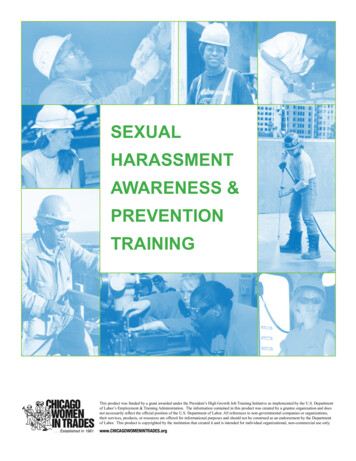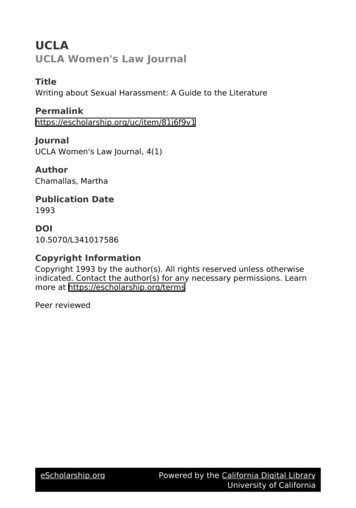
Transcription
UCLAUCLA Women's Law JournalTitleWriting about Sexual Harassment: A Guide to the m/81j6f9v1JournalUCLA Women's Law Journal, 4(1)AuthorChamallas, MarthaPublication Date1993DOI10.5070/L341017586Copyright InformationCopyright 1993 by the author(s). All rights reserved unless otherwiseindicated. Contact the author(s) for any necessary permissions. Learnmore at https://escholarship.org/termsPeer reviewedeScholarship.orgPowered by the California Digital LibraryUniversity of California
ESSAYSWRITING ABOUT SEXUAL HARASSMENT:A GUIDE TO THE LITERATUREMartha Chamallas*INTRODUCTIONSexual harassment law is of particular interest to feministtheorists confronting the capacity of law to promote culturalchange. Because sexual harassment was not regarded as a dis-crete injury prior to the campaign for its inclusion as a form ofsex discrimination under Title VII of the Civil Rights Act,' thechange in the law has done more than simply create new legalrights. This feminist intervention into the law has affected thecultural meaning of interactions between men and women in theworkplace, even when the new meanings have not translated intolegal victories.The legal claim for sexual harassment is notable for its distinctively feminist origins. Born in the mid-1970s, the term wasinvented by feminist activists, given legal content by feminist liti* Professor of Law, University of Iowa. I wish to thank Liza Diaz for herresearch assistance.1. Title VII of the Civil Rights Act of 1964 makes it unlawful for any employer"to discriminate against any individual with respect to his compensation, terms, conditions, or privileges of employment, because of such individual's race, color, religion, sex or national origin." 42 U.S.C. § 2000e-2(a)(1) (1988). The original Act didnot mention sexual harassment, nor did it provide for damages for civil rights plaintiffs. The Civil Rights Act of 1991 clearly contemplates actions for sexual harassmentand permits plaintiffs to recover compensatory and punitive damages up to a maximum of between 50,000 and 300,000, depending on the size of the employer. 42U.S.C. § 1981a(a)(1), (b) (Supp. III 1991). Jury trials are now available under TitleVII for plaintiffs seeking damages for intentional discrimination. 42 U.S.C.1981a(c)(1) (Supp. III 1991). The most comprehensive treatment of sexualharassment doctrine can be found in BARBARA LINDEMANN & DAVID D. KADUE,SEXUAL HARASSMENT IN EMPLOYMENT LAW(1992).
38UCLA WOMEN'S LAW JOURNAL[Vol. 4:37gators and scholars, and sustained by a wide-ranging body ofscholarship generated largely by feminist academics. Sexualharassment is the quintessential feminist harm - in CatharineMacKinnon's words, "the first time in history . that womenhave defined women's injuries in a law."2 The goal of legal feminism has been to fit the cause of action to women's experience inthe workplace. As a phenomenon, sexual harassment is virtuallygender-specific: unlike other types of sex discrimination suitswhere male plaintiffs frequently complain of gender-based injury, the great majority of sexual harassment plaintiffs are women, and their complaints rarely have a precise analogue in the3experience of men.In its twenty year life span, the legal literature on sexualharassment has peaked at three points. The first wave occurredjust prior to and following the adoption of the Guidelines on Sexual Harassment by the Equal Employment Opportunity Commission in 1980.4 These early books and articles described thephenomenon of sexual harassment from women's point of viewand countered the stock objections to treating harassment assomething other than harmless flirtation. The second wave ofscholarship came in response to Meritor Savings Bank v. Vinson,5the 1986 Supreme Court decision that formally established sexualharassment as a violation of Title VII. Writers analyzed and crit2. CATHARINE A. MACKINNON, Sexual Harassment:Its First Decade in Court(1986), inFEMINISM UNMODIFIED: DISCOURSES ON LIFE AND LAW 103, 105 (1987).3. The Equal Employment Opportunity Commission reported that in 1992,968of the 10,577 sexual harassment claims were filed by men. In 1991, 514 out of a totalof 6886 claims were filed by men. The Commission figures do not indicate whatpercentage of the male respondents claim that they were harassed by women. ManWins 1 Million Sex Harassment Suit, N.Y. TIMES, May 21, 1993, at A15. Maleplaintiffs have frequently complained of sexually abusive treatment by male coworkers who taunt them because of their homosexuality or perceived homosexuality. The courts have so far refused to treat harassment based on sexual orientationas actionable under Title VII. See, e.g., Dillon v. Frank, 952 F.2d 403 (6th Cir. 1992);Goluszek v. Smith, 697 F. Supp. 1452 (N.D. I1. 1988); Polly v. Houston Lighting &Power Co., 62 Fair Empl. Prac. Cas. (BNA) 627, 629-30 (S.D. Tex. 1992). A fewheterosexual males have fared better in the courts. A married couple recently won asexual harassment suit against their boss who treated them both abusively. The bossboasted to the husband that he would make a better lover for the wife than herhusband. Chiapuzio v. BLT Operating Corp., 62 Fair Empl. Prac. Cas. (BNA) 707(D. Wyo. 1993). A California jury has recently awarded a one million dollar verdictagainst a female supervisor charged with harassing a male employee. The award isthe largest against a female harasser. Man Wins 1 Millon Sex Harassment Suit,supra, at A15.4. EEOC Guidelines on Sexual Harassment, 29 C.F.R. § 1604.11 (1993).5. 477 U.S. 57 (1986).
WRITING ABOUT SEXUAL HARASSMENT1993]39icized the various elements of proof that courts had engraftedonto the sexual harassment claim and expressed concerns thatsexual harassment victims were facing a series of legal obstaclesreminiscent of those encountered by rape victims. The Hill/Thomas hearings in the fall of 1991 were a major force behindthe third wave of scholarship. The recent reflection pieces in thelaw reviews discuss the intersection of race and gender in women's experience of harassment, and how race, sexual orientation, and other dimensions of personal identity affect ourunderstanding of the meaning of sexual harassment.This Essay provides an overview of the legal literature onsexual harassment, 6 with attention to major trends in the emerging legal doctrine. The works I discuss also have significance forthe development of feminist legal theory; in several respects thesexual harassment literature is a microcosm of broader theoretical shifts that have occurred in feminist theory in the last two7decades.I.THE FIRST WAVE: FOUNDATIONS AND HISTORYIn legal circles, Catharine MacKinnon's book, SexualHarassmentof Working Women, published in 1979, has undoubtedly been the most influential text on sexual harassment. 8 Thebook is a classic in feminist scholarship, blending particularizedaccounts of women's experience of sexual harassment with a coherent, persuasive legal argument for prohibiting harassment as aviolation of women's civil rights. Its practical contribution was tocreate two legal categories for describing and proving sexualharassment. MacKinnon's quid pro quo and offensive workingenvironment (or condition of work) types of sexual harassment 96. The articles discussed and cited in this essay represent only a very smallpercentage of the articles written on sexual harassment. Several high quality articlesare not treated in this essay because of the limitations of space and my emphasis onarticles focusing on feminist theory. I also limited my discussion to articles that werepublished prior to August 1993.7. For those unfamiliar with feminist legal theory, the following providethoughtful analyses of the major shifts in scholarship: Patricia A. Cain, Feminist Jurisprudence: Grounding the Theories, 5 BERKELEY WOMEN'S L.J. 191 (1989-90);Clare Dalton, Where We Stand: Observations on the Situation of Feminist LegalThought, 3 BERKELEY WOMEN'S L.J. 1 (1987-88).8. CATHARINEA.MACKINNON, SEXUAL HARASSMENT OF WORKING WOMEN:A CASE OF SEX DISCRIMINATION (1979).9. Quid pro quo sexual harassment takes place when a supervisor threatensharm or promises a benefit in exchange for sexual compliance. In quid pro quocases, the harassment is directly linked to the grant or denial of an economic benefit.
40UCLA WOMEN'S LAW JOURNAL[Vol. 4:37were later taken up by the EEOC and the courts and providedthe basic doctrine for organizing litigation.For MacKinnon, sexual harassment was best viewed as astructural feature 1 of women's inferior position in the workplace. Influenced by the work of sociologist Rosabeth MossKanter," MacKinnon constructed a structuralist account of sexual harassment that deprivatized and depersonalized the injury.MacKinnon argued that women in feminized jobs - the vastforce of pink collar workers - were "set up" for sexualharassment.In such jobs a woman is employed as a woman. She is also,apparently, treated like a woman, with one aspect of this beingthe explicitly sexual. Specifically, if part of the reason the woman is hired is to be pleasing to a male boss, whose notion of aqualified worker merges with a sexist notion of the proper roleof women, it is hardly surprising that sexual intimacy, forcedwould be considered part of her duties andwhen necessary,12his privileges.For women in male-dominated jobs, MacKinnon theorized thatthe "token" woman was often singled out for harassment becauseshe was highly visible, marked by her sex, and an easy target for13male co-workers who resented the invasion of their territory.Describing a feedback loop, MacKinnon showed how sexualharassment simultaneously kept women out of nontraditionalEEOC Guidelines provide for liability when "submission to such conduct is madeeither explicitly or implicitly a term or condition of an individual's employment [or].is used as the basis for employment decisions affecting such individual." 29C.F.R. § 1604.11(a)(1)(2) (1993); see Meritor Savings Bank v. Vinson, 477 U.S. 57,62 (1986). Offensive working environment occurs when the harassing conduct of asupervisor, co-employee, or third party (e.g., client or customer) "has the purpose oreffect of unreasonably interfering with an individual's work performance or creatingan intimidating, hostile, or offensive working environment." 29 C.F.R.§ 1604.11(a)(3) (1993).10. Structuralist accounts of workplace behavior and workers' attitudes placeprimary importance on organizational structures and cultures and downplay the significance of individual beliefs and choices. Thus, MacKinnon stresses that womenare susceptible to harassment because of occupational segregation, a situation inwhich most women occupy low status, low paying jobs and tend to be supervised bymen. MACKINNON, supra note 8 at 10-18. More recently, Vicki Schultz has employed a structuralist approach to criticize the court's ruling in the controversial caseof EEOC v. Sears, Roebuck & Co., 628 F.2d 1264 (N.D. II1.1986), aftd, 839 F.2d302 (7th Cir. 1988). Vicki Schultz, Telling Stories About Women and Work: JudicialInterpretationsof Sex Segregation in the Workplace in Title VII Cases Raising theLack of Interest Argument, 103 HARV. L. REV. 1749 (1990).11. See ROSABETH Moss KANTER, MEN(1977).12. MACKINNON, supra note 8, at 18.13. Id. at 9, 40.AND WOMEN OF THE CORPORATION
1993]WRITING ABOUT SEXUAL HARASSMENT41jobs and reinforced the image of workers in women's jobs as sexually accessible.MacKinnon's legal argument against sexual harassmentdrew much of its power from the analogy she made to race discrimination. In at least some race discrimination cases, MacKinnon believed that the courts had recognized "the socially created,systemic, historical, and group-defined character of racial status."'1 4 She maintained that this "substantive" description of thenature and effects of racism could and should be applied to sex.In Sexual Harassment of Working Women, MacKinnon first pro-5posed her now-famous "inequality" or "dominance" approach'and argued that because sexual harassment had the effect of subordinating women to men in the workforce, it should be declaredunlawful.Outside of legal circles, the appearance in 1978 of Lin Farley's book, Sexual Shakedown, also helped to establish sexualharassment as an important topic on the feminist agenda. 16 Farley's tracing of the history of sexual harassment is astute: shenotes that although the term "sexual harassment" was not coineduntil the mid-1970s, the abusive practice has a much longer history. Farley describes the sexual exploitation of slave women bytheir masters and mill workers by their foremen as early examples of sexual harassment.The historical aspects of sexual harassment have not yet received much attention in the legal literature. Jill Laurie Goodman's article, 17 published as part of the 1981 symposium onsexual harassment in the Capital University Law Review, containsa good synopsis of historical sources. The most sophisticated historical treatment of sexual harassment is Elvia Arriola's 1990 article' 8 which takes a "social approach to legal history" and14. Id. at 132.15. In SEXUALHARASSMENT OF WORKING WOMEN:A CASEOF SEX DISCRIMI-MacKinnon called this approach, the "inequality approach." Id. at 102. Inher later book, FEMINISM UNMODIFIED, DISCOURSES ON LIFE AND LAW, MacKinNATION,non renamed the approach the "dominance approach." CATHARINE A. MACKIN.NON, Difference and Dominance: On Sex Discrimination (1984), republished inFEMINISM UNMODIFIED, DISCOURSES ON LIFE AND LAW 40 (1987).16. LIN FARLEY, SEXUAL SHAKEDOWN: THE SEXUAL HARASSMENT OF WOMENON THE JOB (1978).17. Jill L. Goodman, Sexual Harassment: Some Observations on the DistanceTravelled and the Distance Yet to Go, 10 CAP. U. L. REv. 445 (1981).18. Elvia R. Arriola, "What's the Big Deal?" Women in the New York City Construction Industry and Sexual HarassmentLaw, 1970-1985, 22 COLUM. HUM. RTs. L.REv. 21 (1990).
UCLA WOMEN'S LAW JOURNAL[Vol. 4:37carefully excavates the key developments since 1970, with a special emphasis on popular culture and on how the law had a different impact on women in blue-collar jobs, particularly women ofcolor and lesbians. For most readers who were not personallyengaged in feminist activism in the early 1970s, Arriola's articlehas the great virtue of providing a context in which to place thelegal doctrine, and conveying a feel for the people, the organizations, and the symbols that gave meaning to the contemporarycampaign against sexual harassment.The foundation established by MacKinnon's and Farley'sbooks and the publication of the EEOC Guidelines also led social scientists to take up the study of sexual harassment as a serious topic for research. These studies proved important for thelaw because the findings of the social scientists were later cited incases to substantiate the claims of sexual harassment victims andto shape the elements of the cause of action. In a recent article,Barbara Gutek provides a useful synthesis of the social scienceresearch. 19 She explains how much of this research focuses onmen's and women's everyday definitions of sexual harassmentand the prevalence of sexual harassment in different contexts.The most prominent finding of the studies discussed by Gutek isthat women typically define sexual harassment more broadlythan men and that these differing perceptions of sexualharassment are consistent with the self-interest of each group.The research is premised on a simple but important observation:"It is in men's self-interest to see relatively little sexualharassment because men are most often the offenders whereas itis in women's self-interest to see relatively more sexualharassment because women tend to be the victims in sexualharassment encounters. 20o This "two worlds" phenomenon documented by social scientists provides the empirical support forchallenging purportedly objective standards in sexual harassmentlitigation and shores up feminist contentions that "objective"standards must be unmasked as knowledge claims based only on21the partial experience of men.19. Barbara A. Gutek, UnderstandingSexual Harassment at Work, 6 NOTREJ.L. ETHics & PUB. POL'Y 335 (1992).20. Id. at 343.21. A central feature of feminist and other critical scholarship is its investigationof the relationship between knowledge and power. The take-home message of muchof this work is that what frequently passes for the whole or universal truth is insteada representation of events from the perspective of those who possess the power tohave their version of reality accepted. Critical feminist scholars look for multipleDAME
1993]WRITING ABOUT SEXUAL HARASSMENT43These early feminist legal critiques, combined with the socialscience research, legitimated sexual harassment as a distinct legalinjury with a real connection to the experiences of women workers. When it came to establishing the specific elements of thelegal claim, however, it was harder to match the emerging legalcategories to feminist conceptions of the harms women actuallysuffer when they are harassed at work.II.THE SECOND WAVE: DOCTRINAL CRITIQUEAND IMPLEMENTATIONTheSupremeCourt did not decide its first sexualharassment case until 1986, a decade after the first case in whichthe lower courts recognized the cause of action. 22 In one respect,Meritor Savings Bank v. Vinson 23 represented a remarkable victory for feminist legal activists: a unanimous Court held that bothtypes of harassment - quid pro quo and hostile or offensiveworking environment - were actionable under Title VII. A veryconservative Court allowed a claim even in those instances inwhich the harassment produced no direct economic injury.24 Inrefining the details of proof required in sexual harassment suits,however, the Court was less protective of the interests ofharassment victims. Departing from the EEOC Guidelines, theCourt ruled that employers were not automatically liable for theharassing acts of supervisory employees in offensive working environment cases. 25 Even after plaintiffs established thatharassment at their workplace was "severe or pervasive," 26 theemployer might still avoid liability by showing that it was unaware of and did not implicitly ratify the supervisor's actions. TheCourt also noted that a plaintiff's provocative dress or public expression of sexual fantasies could be admitted into evidence to27discredit her allegations and defeat her claim.meanings and multiple perspectives in analyzing legal texts and human events. Seegenerally MARTHA MINOW, MAKING ALL THE DIFFERENCE: INCLUSION, EXCLUSIONAND AMERICAN LAW 184-214 (1990); Kathryn Abrams, Hearing the Call of Stories,79 CAL. L. REV. 971, 1013-16 (1991); Dennis M. Patterson, Postmodernism/Feminism/Law, 77 CORNELL L. REV. 254 (1992).22.Saxbe,23.24.The first case to recognize the claim of sexual harassment was Williams v.413 F. Supp. 654 (D.D.C. 1976).477 U.S. 57 (1986).Id. at 64.25. Id. at 72.26. Id. at 67.27. Id. at 69.
UCLA WOMEN'S LAW JOURNAL[Vol. 4:37A. Elements of ProofThe most thorough critique of Meritor Savings Bank and thelower courts' handling of sexual harassment cases is Sex atWork, 28 Susan Estrich's 1991 article in which she applies many ofthe same arguments she first employed in her work on the law ofrape. 29 Estrich contends that "[t]hese very same doctrines,unique in criminal law, are becoming familiar tools in sexualharassment. '30 Estrich aims to convince the courts to abandonseveral limitations they have engrafted onto the newly elaborated cause of action.At the heart of Estrich's critique is her assessment that oftenthe conduct of the sexual harassment victim, rather than the conduct of the harasser, is scrutinized during the course of the litigation. The victim who does not behave in the way the courtbelieves a reasonable woman should behave is penalized. Estrichclaims that because so few real women measure up to these expectations, it is exceedingly difficult to secure legal protection.One judges the woman's injury from a perspective which ignores the woman's views; or one compares her view to that ofsome ideal reasonable woman, or that of women afraid tospeak out against harassment for fear of losing their jobs; andthus one 31applies a standard that the victim cannot and doesnot meet.One problematic element of proof is the requirement thatthe plaintiff prove that the harasser's conduct was "unwelcome,"regardless of how objectionable the conduct might appear. Estrich observes that "unwelcomeness has emerged as the doctrinalstepchild of the rape standards of consent and resistance, andshares virtually all of their problems. ' 32 Estrich makes a persuasive case for doing away with the unwelcomeness requirement inboth quid pro quo and offensive working environment cases, arecommendation echoed by other commentators. 33 As she readsthe cases, Estrich sees the harassment victim caught in the famil28. Susan Estrich, Sex at Work, 43 STAN. L. REV. 813 (1991).29. See SUSAN ESTRICH, REAL RAPE (1987). Estrich was not the first legalcommentator to compare the judicial treatment of sexual harassment cases to rapeprosecutions. For an earlier critique, see Joan Vermeulen, Employer Liability UnderTitle Vl for Sexual Harassmentby Supervisory Employees, 10 CAP. U. L. REv. 499,523-24 (1981).30. Estrich, supra note 28, at 815.31. Id. at 815-16.32. Id. at 827.33. See, e.g., Deborah L. Rhode, Sexual Harassment, 65 S. CAL. L. REv. 1459,1463 (1992).
1993]WRITING ABOUT SEXUAL HARASSMENT45iar double-bind when the courts evaluate whether she welcomedthe behavior about which she now complains.In practice, both traditional and nontraditional women mayfind that their own actions are used against them in the unwelcomeness analysis. A woman who behaves in the moststereotypical ways - complimenting men, straightening theirties, "mov[ing] her body in a provocative manner," let aloneeating dinner with the boss on a business trip, or remainingfriendly even after rejecting his advances - may find that thesexual advances she rejects are, as a matter of law, not unwelcome. Similarly, women who act too much like men - whouse "crude and vulgar language," or choose to eat with themen in the employee lunchroom - cannot be heard to complain of a worksite which is "permeated by an extensive34amount of lewd and vulgar conversation and conduct."Estrich also takes issue with the requirement that plaintiffsin offensive working environment cases prove that theharassment was severe or pervasive. This qualification tends tolimit relief to only the most egregious cases. Estrich maintainsthat even sporadic harassment can be harmful and argues thatthe quantum and severity of the harassment should affect onlythe amount of recovery, not determine the basic question of liability. 35 Most recently, B. Glenn George has proposed that thecourts refine the elements of proof in offensive working environment litigation to encompass all discriminatory behavior that isongoing and regular, even if the conduct might be regarded astrivial.Imagine an employer who provides a coffee pot in each maleemployee's office, but requires female employees to use acommon coffee pot at the end of the hall. The "trivial" inconvenience of walking a few extra steps to get coffee is hardly"abusive" and is unlikely to interfere substantially, or evenminimally, with a woman's ability to perform 36her job. But thesymbolic implications are clearly intolerable.So far, the courts have shown little inclination to ease thesexual harassment plaintiff's burden in the direction Estrich andGeorge propose. As the authors acknowledge, dispensing withsuch elements as proof of unwelcomeness and pervasiveness34. Estrich, supra note 28, at 830.35. Id. at 843-47.36. B. Glenn George, The Back Door: Legitimizing Sexual Harassment Claims,73 B.U. L. REV. 1, 21 (1993).
UCLA WOMEN'S LAW JOURNAL[Vol. 4:37would open up the courts to typical cases and expose the wide37spread dimensions of the problem.B.Credibility of Harassment VictimsA recurring theme of writers who have studied sexualharassment cases is that the courts treat sexual harassment plaintiffs with undue skepticism. Like rape victims, sexual harassmentvictims are said to lack credibility. In Sexual Harassment: Women's Experience vs. Legal Definitions, Wendy Pollack concludesthat "[t]he overwhelming impression created by hostile work environment sexual harassment cases is that, regardless of the standard applied, women simply are not trusted. This is true fordecisions that find for plaintiffs as well as those which find'38against them.The literature contains a rich discussion of the reasons whywomen are not accorded credibility in this context. Susan DellerRoss 39 explores the case of Richard Berendzen, the former President of American University who was forced to resign afterpleading guilty to making obscene phone calls. She makes thepoint that absent hard evidence (like the tape recordings in theBerendzen case), most people will tend to believe the morehighly-ranked and credentialed person, particularly if there aresome readily available myths about women that can be used todiscredit the lower-ranking woman. Reflecting upon thethousands of letters she received after the confirmation hearings,Anita Hill describes the "most disheartening stories" as those involving mothers who did not believe their daughters' accounts ofsexual harassment. Hill speculates that these instances of distrustmay "represent attempts to distance ourselves from the pain ofthe harassment experience," attempts to convince ourselves that'it couldn't happen to me because it really didn't happen to37. As this Essay went to press, a unanimous Supreme Court decided Harris v.Forklift Sys., No. 92-1168, 1993 U.S. LEXIS 7155 (U.S. Nov. 9, 1993). The Courtrefused to require plaintiffs to prove that they suffered severe psychological harm inoffensive working environment cases. Proof of "unwelcomeness" and "severity orpervasiveness" are still required elements of the prima facie case.38. Wendy Pollack, Sexual Harassment: Women's Experience vs. Legal Definitions, 13 HARV. WOMEN's L.J. 35, 69 (1990).39. Susan D. Ross, Proving Sexual Harassment:The Hurdles, 65 S. CAL. L. REv.1451, 1452-63 (1992).
1993]WRITING ABOUT SEXUAL HARASSMENT47her.' 4 Penelope Bryan 4 ' explores the nature of the traumawhich women experience when they suddenly realize that theirwords will not be believed. The lack of credibility exposes women's vulnerability and takes away their ability to challenge discrimination. Ironically, this may result in women identifyingwith those in power, rather than identifying with other women.At trial, defendants often try to destroy the credibility ofsexual harassment plaintiffs by introducing evidence bearing onplaintiff's dress, sexual history, or other sexual conduct outside ofwork. Such evidence of "provocative" dress or other sexualizedconduct purports to bear on whether plaintiff "welcomed" theadvances. However, several commentators have observed thatthe portrayal of the harassment victim as a "bad girl" tends tojustify a denial of protection, even when it is clear that the plaintiff subjectively did not desire the sexual conduct directed ather. 42 Wendy Pollack effectively uses narrative to unpack themale-dominated notion of "provocative" dress and calls intoquestion the Supreme Court's ruling that what a plaintiff wearsto work is relevant to whether she was sexually harassed:What is provocative? As an apprentice carpenter I attended aschool two days a month that housed a variety of apprenticeship programs. Every day the cafeteria served lunch to 300 to400 apprentices, all men except for three or four women.Whenever a woman walked through the cafeteria, especially ayoung woman, the place would go wild. The men would shout,whistle, and howl until the woman left the room. One womanin particular was a favorite target for this behavior. She was anapprentice painter. She wore the same white painters' pantsthat all the other painters wore. There was nothing in herdress or manner that welcomed the men's behavior. The onlyattention that I could identify was thatpossible cause of this43she had blond hair.Feminist theorists have recognized that the lack of credibility afforded to sexual harassment victims is closely linked to theminimization of the injury of sexual harassment. Martha Maho40. Anita F. Hill, Sexual Harassment: The Nature of the Beast, 65 S. CAL. L.REv. 1445, 1446 (1992).41. Penelope E. Bryan, Holding Women's Psyches Hostage: An InterpretiveAnalogy on the Thomas/Hill Hearings, 69 DENV. U. L. REV. 171 (1992).42. See Martha Chamallas, Consent, Equality, and the Legal Control of SexualConduct, 61 S. CAL. L. REV. 777, 807 (1988); Linda J. Krieger & Cindi Fox, Eviden-tiary Issues in Sexual HarassmentLitigation, 1 BERKELEYWOMEN'SL.J. 115 (1985);Catharine A. MacKinnon, Introduction,Symposium: Sexual Harassment, 10 CAP. U.L. REv. i, iii (1981).43. Pollack, supra note 38, at 57 n.73.
UCLA WOMEN'S LAW JOURNAL[Vol. 4:37ney's scholarship" brilliantly disentangles the dilemma of thesexual harassment victim who "chooses" to stay on the job, despite the hostile environment, and by staying runs the risk of being told that the abuse is not serious enough to warrant legalintervention. Mahoney challenges the popular notion that "exit"is the normal and appropriate response to abuse, drawing ananalogy to domestic violence. Mahoney first makes a strong casefor the proposition that few workers actually have the luxury (ormake the choice) "to take this job and shove it."Exit is not the norm for many workers who encounter painfulchoices about work. Workers threatened by plant closings orjob cuts make givebacks on wages and working conditions.When women face particularly agonizing choices in relation towork, they often internalize the pain and keep the job. This iswhy there were sterilized plaintiffs in fetal protection cases45and why latchkey children care for themselves after
1993] WRITING ABOUT SEXUAL HARASSMENT 41 jobs and reinforced the image of workers in women's jobs as sex-ually accessible. MacKinnon's legal argument against sexual harassment drew much of its power from the analogy she made to race dis-crimination. In at least some race discrimination cases, MacKin-

